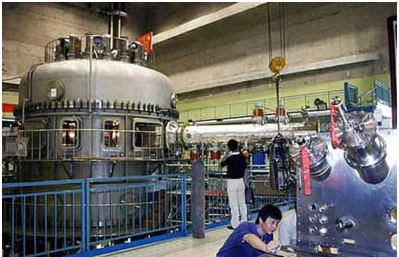In 2006, China completed the Experimental Advanced Superconducting Tokamak (EAST) test reactor at Hefei, the capital city of Anhui Province. The EAST is the first tokamak to use superconducting magnets for both the toroidal and poloidal fields.
In 2009, the National Ignition Facility (NIF) is completed at Lawrence Livermore National Laboratory. The NIF is an inertial confinement fusion reactor with a spherical configuration of lasers that heats and compresses a pellet of hydrogen in order to generate a fusion reaction. The Fusion Power Corporation files a patent for a "Single Pass Radio Frequency Driver which is a Radio Frequency Accelerator Driven Heavy Ion Fusion Process and Method. "A new arrangement of current multiplying processes that employs multiple isotopes to achieve the desired effect of distributing the task of amplifying the current among all the various processes, to relieve stress on any one process, and to increase margin of safety for assured ICF."
In 2010, at the Heavy Ion Fusion-2010 Symposium in Germany, Robert Burke presents a report on Single Pass HIF. Charles Helsley projects the commercialization of Heavy Ion Fusion by 2020.
In 2011, at the Workshop for Accelerators for Heavy Ion Fusion at Lawrence Berkeley National Laboratory is held in May, Robert J. Burke presents his report on "Single Pass Heavy Ion Fusion". The Accelerator Working Group makes recommendations with respect to moving toward commercial fusion power utilizing Radio Frequency Accelerator Driven HIF (SPRFD).
In 2012, Stephen Slutz and Roger Vesey of Scandia National Laboratories published a paper in Physical Review Letters describing a computer simulation of Magnetized Liner Inertial Fusion (MagLIF). In MagLIF, a one hundred nanosecond pulse of electricity is run through a cylinder that contains a hydrogen pellet. The current generates a powerful zeta pinch magnetic field which compresses the cylinder causing it to implode. Just prior to implosion, the hydrogen pellet is heated with a laser beam. The MagLIF combines features of both inertial confinement fusion and magnetic confinement, the two main approaches to nuclear fusion. The computer simulation suggests that MagLIF may be able to generate one thousand times the energy that is input to trigger fusion.
The Joint European Torus in the UK announces that it has made a major breakthrough in controlling plasma instability which is one of the main problems encountered in magnetic confinement.
The Nineteenth International Heavy Ion Fusion Symposium is held in Berkeley, California. Burke presents updates to his work on SPRFD HIF. Helsley gives a report on the economics of SPRFD for commercial generation of electricity. Fusion Power Corporation obtains a Russian patent for SPRFD.
In 2013, the Chinese EAST test reactor manages to confine a plasma for thirty seconds which represents a record. This breakthrough is ten times better than other tokamaks have been able to achieve to date.
This concludes my presentation of the history of world fusion research.
Chinese Experimental Advanced Superconducting Tokamak:
